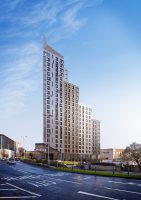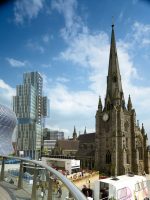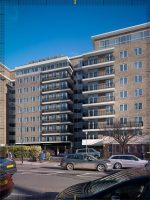Visual Eyes Media are a specialist design company that produce Accurate Visual Representations (AVRs); a form of computer visualisation that can assist in the assessment of the visual effects of specific proposals on designated views. An Accurate Visual Represenation or Verified View is a tool used in the planning process that helps to inform the effect of a proposal by providing three dimensional visualisations of it. These images can be very realistic and should be accurate with respect to height, form, size and location.
An example case study can be found here
PURPOSE
By accurately combining an image of a proposed development with a representation of its existing context, all AVRs / verified views explain the location and massing of a proposed development. They may also illustrate additional properties including the degree of visibility, architectural form or choice of materials selected.
In their most sophisticated form they give a very useful impression of how a completed development would look in its environment under specific lighting and weather conditions.
PROCESS
A brief non-technical outline of the process involved is as follows:
- Selection of required viewpoint through a process of consultation giving regard to relevant planning guidance.
- Photography of required view’s ensuring the precise location of the camera and date and time is recorded.
- The view’s to be then surveyed using the information recorded at the time of the sourcing the photography and also reference points within the photography.
- Using these points, the appropriate parameters can be calculated to permit a view of the computer model to be generated which exactly overlays the photograph.
- The Computer model is appropriately lit and textured to allow for a qualitative assessment of the proposed scheme.
- In addition to the finalised image a formal document is issued outlining the complete methodology of the view or views produced.
Quality
Visual Eyes Media offer four levels of render quality which is usually agreed upon by all parties prior to works commencing. The following classifications broadly define the purpose of the AVR in terms of the visual properties that it represents. The classifications are cumulative with each additional level incorporating all of the properties of the previous level.
- AVR Level 00 – Showing Location & size (as a toned area superimposed on a photograph).
- AVR Level 01 – Confirming level of visibility (as an occluded ‘wireline’ image).
- AVR Level 02 – Explaining Architectural Form (as a simply shaded render in a uniform opaque material).
- AVR Level 03 – Confirming the use of materials using ‘photo-realistic’ render techniques.
PHOTOGRAPHY
Whilst traditionally architectural photography has always been sourced using 35mm plates with the fast development of digital photography it is now possible to surpass the quality and resolution of these traditional methods. Digital photography also offers a more efficient media when it comes to reviewing and processing avoiding the requirement of transparency development, scanning and their associated threshold to possible error.
Visual Eyes Media use a specialist architectural photographer to source any photography used within the AVR’s. The photographer has a clear understanding of the processes involved and understand the recorded data required.
SURVEY
Visual Eyes Media out source the survey requirements to a survey team that has a vast array of experience in the production of ‘view surveys’. Given the source photography and the viewpoint location the survey team uses a control network (usually the Ordnance Survey National grid and Datum) to create a cloud of view specific survey points that can be used in the positioning of the virtual camera with in the 3D space to match the real world camera.
All points are documented and this documentation is issued as part of the methodology statement.
METHODOLOGY
It is important that AVR’s prepared to assist the Qualitative Visual Assessment of a new proposal should be accompanied by a well written, helpful statement confirming the techniques employed and the decisions made.
This ‘method statement’ will contain sufficient detail to allow assessors to understand the documents presented, conduct reliable comparisons between AVR’s within the same set and allow AVR’s prepared under one methodology to be compared with others prepared using another.
Method statements are expressed in non-specialist terminology which is comprehensible to the wide range of professional disciplines likely to be involved in Qualitative Visual Assessment.









